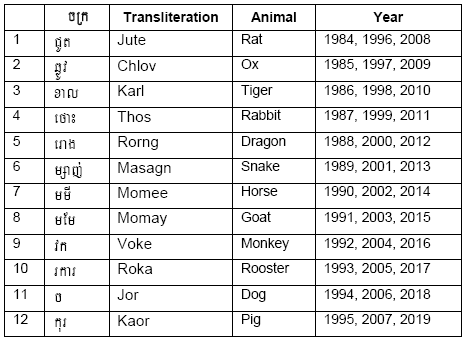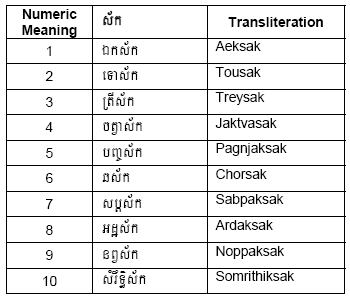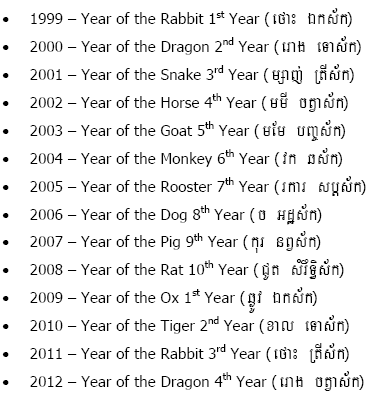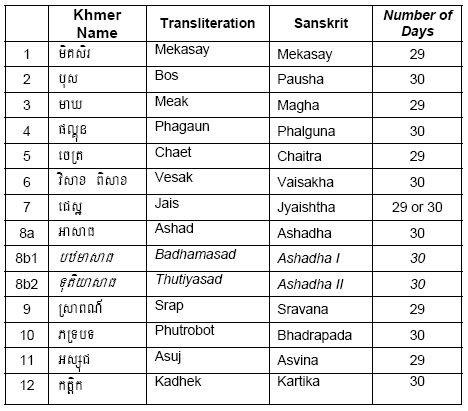
Khmer traditional calendar, known as Chhankitek, is a lunisolar calendar although the word Chhankitek itself means lunar calendar. While the calendar is based on the movement of the moon, calendar dates are also synchronized with the solar year to keep the seasons from drifting. Since the number of days in a lunar year is shorter than the solar year, the synchronization is accomplished by adding an additional month or day to a particular year.
Cambodians commonly identify a year by using a system of 12 animals in conjunction with a ten-numeric cycle system. Years may also be identified using several different era. Since the majority of the Cambodians are Buddhist, Buddhist Era was widely used. Buddhist Era (BE) began when Buddha passed away at the age of 80 (544 BC). Cambodians also use Jolak Sakaraj which is an era that began at 1183 BE and Moha Sakaraj, an era that began at 78 AD. [KHH67]
The twelve animals that identify the Cambodian year are: rat, ox, tiger, rabbit, dragon, snake, horse, goat, monkey, rooster, dog and pig. These animals are named in Khmer as Jute, Chlov, Karl, Thos, Rorng, Masagn, Momee, Momay, Voke, Roka, Jor, and Koar respectively. Names in Khmer are not translation words for each of the animals but are special names created for each year. Cambodians believe that each animal possess specific and unique qualities; people born to a particular animal year share explicit qualities associated with that animal. These qualities determine a person's characteristics including personality, fame and fortune. The table below shows the 12 animals and examples of AD years that the animal represents.

Sak in Khmer means era or counting the sequence of year which refers to a numbering scheme from one to ten used to identify a particular year. It starts with a key word Aek, Tou, Trey, Jaktva, Pagnjak, Chor, Sabpak, Ardak, Noppak, and Somrithik which means one to ten respectively. Then the word "sak" is added to the end of each word. So Aeksak means the first year and Tousak means the second year and so on until Somrithiksak which means the tenth year. Cambodians use the Sak system to distinguish the same animal years that are in a different 12-year cycle. As an example, a 20-year old person is born on the same animal year as 32-year old person, but are born on a different sak.
The table below shows the ten-year cycle of Sak and its meanings.
Sak and animal years are cycled (or incremented) simultaneously. The following are some examples of animal years and the corresponding Saks.

Apart from this 60-year cycle, Cambodians also use several counting systems to reckon the year including Put Sakaraj or Buddhist Era (BE), Moha Sakaraj (Saka), Jolak Sakaraj, and Christ Sakaraj (AD). See appendix for more information about these different eras. Also see the appendix for methods for finding Sak or animal year from different eras.
Khmer solar months correspond to the twelve months in Gregorian calendar. Each of the months refers to a particular Reasey that can be translated to a Zodiac sign. For example, the Zodiac sign for the Khmer month of Seiha (August) is Reasey Seihak which is Leo (the lion). A year is divided into 12 Reaseys. Each Reasey has the 30-degree measurement of the path that the Earth travels around the sun. See the appendix for the list of Reaseys.
A lunar year is divided into 12 Reaks, a symbol for lunar months similar to Zodiac representations in solar months. For example, the first month of a lunar year is Mekasay and the Reak for this month is deer. Reaks do not use the degree measurement like Reasey. See the appendix for a complete list of Reaks.
Khmer lunar months start from one new moon to the next. The month begins with Mekasay, which has 29 days then Bos, which has 30 days. The number of days alternate every month. The last month of the year is Kardek, which has 30 days. A normal year is 354 days.
The following is a list of Khmer lunar months and the number of days:

Since a lunar month is about 29.5 days, one lunar year is 354 days, which is shorter than the solar year by 11 days. Adjusting for this discrepancy, an extra month is added every two to three years. An extra day is also added to a particular year to maintain the synchronization.
A leap year can have an extra month or an extra day.
The extra leap-day occurs in the month of Jays (ជេស្ឋ) which has 30 days instead of the normal 29 days.
Unlike the Indian and Chinese calendar where any month can become leap months, Khmer leap month is always in the month of Ashad. Adhikameas has two months of Ashad (អាសាធ). The first month of Ashad is called Badhamasad (បឋមាសាធ) and the second month is called Thutiyasad (ទុតិយាសាធ). In the year of Adhikameas both Badhamasad and Thutiyasad months have 30 days making the number of days in that year totaling 384 days. Only one type of leap year can occur at a time. There is no year with both an extra day and an extra month as in the case for the Chinese calendar.
Khmer lunisolar calendar counts the day by using Keit (កើត) and Roaj (រោច). Keit signifies that the moon is in its waxing phase. Keit is counted from a new moon to a full moon. The number is counted from one to fifteen incrementally. So the new moon is one Keit and the full moon is fifteen Keit. Then it continues with one Roaj. Roaj indicates that the moon is in its waning phase going from full moon to new moon. Depending on the number of days in that month, Roaj can go from one to fourteen for a 29-day month or one to fifteen for a 30-day month.
This counting system occurs consistently throughout each month and differs from the Indian lunisolar calendar where the date or tithi can skip a day depending on the moon phase. In both the Indian and Chinese calendar, the number of days per month varies from year to year.
| << Calendar Background | < Table of Content > | Initial Approach >> |